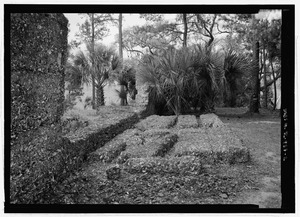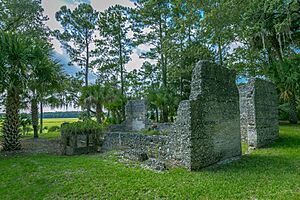Callawassie Sugar Works facts for kids
Quick facts for kids |
|
|
Callawassie Sugar Works
|
|
| Nearest city | Okatie, South Carolina |
|---|---|
| Area | less than one acre |
| Built | 1740 |
| NRHP reference No. | 13001096 |
| Added to NRHP | May 27, 2014 |
The Callawassie Sugar Works is a very old industrial site in Okatie, South Carolina. It is located on Callawassie Island in Beaufort County. This site has the tabby ruins of two buildings. Tabby is a special type of cement. There is also evidence of a third building. The sugar works was built around 1815-1818. It was a place where sugar cane was processed into sugar.
Contents
What is the Callawassie Sugar Works?
The Callawassie Sugar Works was a complex of buildings. It was used to turn sugar cane into sugar. The site includes the remains of a sugar mill and a boiling house. There is also evidence of a curing shed. These buildings were part of a larger settlement. This settlement likely included homes for workers. It might also have had a house for an overseer.
Who Built the Sugar Works?
The sugar works was built soon after 1816. At that time, Callawassie Island was owned by James Hamilton, Jr.. We don't know who the exact architect or builder was. It is thought that the sugar mill was built within three years. Its design might have been similar to mills in the West Indies.
James Hamilton, Jr. (1786-1857) was likely the person who started the Callawassie Sugar Works. His father was an aide to General George Washington. James Hamilton, Jr. was also related to Thomas Lynch, Jr.. Thomas Lynch, Jr. signed the Declaration of Independence. Hamilton served in the War of 1812.
He had family and business connections to important people. These connections included a large rice planter and an investor. They all wanted to start new industries like sugar production. Hamilton also knew many people involved in the Caribbean sugar trade. He sold the property in early 1819 and moved away. It seems the sugar works was still working when it was left. Ashes were found in the furnace.
How the Sugar Works Operated
The Callawassie Sugar Works was built based on ideas from Thomas Spalding. It had three main parts:
- A mill
- A boiling house
- A curing shed
The boiling house and curing shed were likely shaped like a "T". Not much of the curing shed is left today. The remaining buildings show the outer walls. The brick boiling train is still visible in the mill. Old mills like this usually had four kettles in a line. The tops of these kettles were raised from the floor.
What Remains Today?
Today, only the foundation of the mill and parts of the boiling house remain. The mill's foundation, made of tabby, is still in great shape. There is no sign that it was ever inside a permanent building. The boiling pans and their supports are gone. However, the boiling train bed, made of fire brick, is still there. An ash pit and wall vents are also intact.
A long tabby wall on the north side of the boiling house fell outwards. But it kept enough shape to help guess where the windows were. Glass found at the site suggests the windows had glass. Only tabby strip foundations are left of the curing shed. It was probably made of wood. All the machinery is gone. Even with time passing, what is left still shows how sugar was processed. This was before steam machines were used in the late 1830s.
The Special Tabby Construction
The sugar mill ruins on Callawassie Island are special. They are called a "unique example of industrial tabby." It is the only one of its kind in South Carolina. Tabby was known as "poor man's masonry." It was made by mixing local materials. These included oyster shells, water, sand, and lime. The Spanish brought this building method to the New World before 1700. Oyster shells from old Native American shell piles were a good source for tabby.
Building a tabby wall involved pouring the mixture in layers. Each layer needed forms or molds. The tabby at the Callawassie Sugar Works was "well compacted and meticulously cast." This means it was carefully made.
Why Was Sugar Produced Here?
The Callawassie Sugar Works is one of the few remaining structures from early sugar production. This was along the Atlantic Coast. In 1816, a tax was put on foreign raw sugar. This made wealthy planters in Georgia and South Carolina think about growing sugar locally.
James Hamilton hoped to succeed, and Thomas Spalding had expertise. However, the weather in the Lowcountry of South Carolina was not ideal for sugar cane. Sugar cane prefers a year-round temperature of 75 degrees Fahrenheit. It also needs at least 60 inches of rainfall. The sugar works on Callawassie Island is the only example of such an early sugar business in the South Carolina Lowcountry.
National Recognition
The Callawassie Sugar Works was added to the National Register of Historic Places on May 27, 2014. This means it is recognized as an important historical site.
Images for kids









